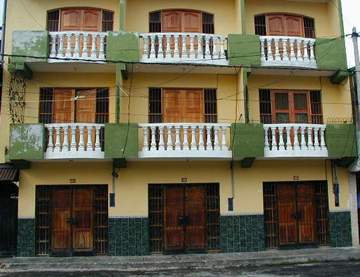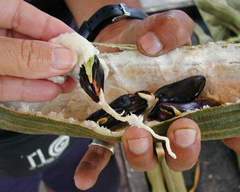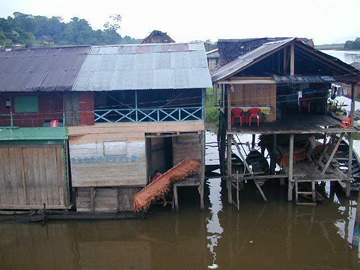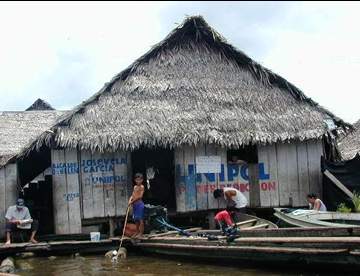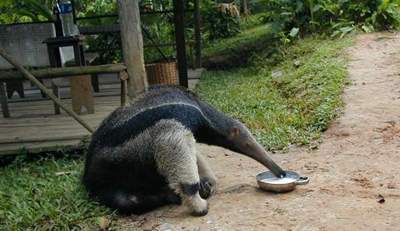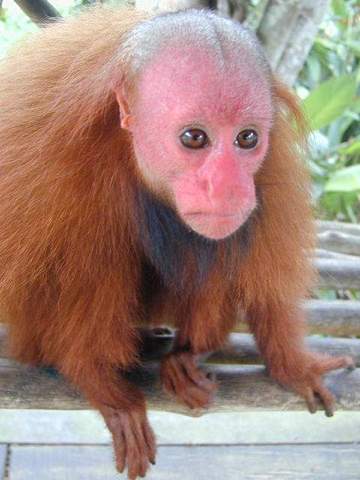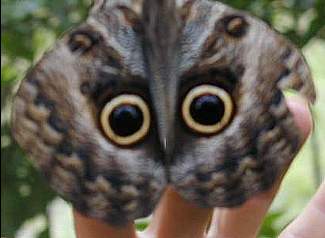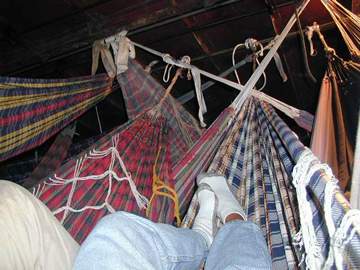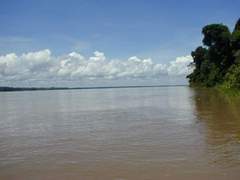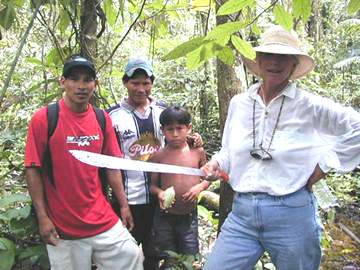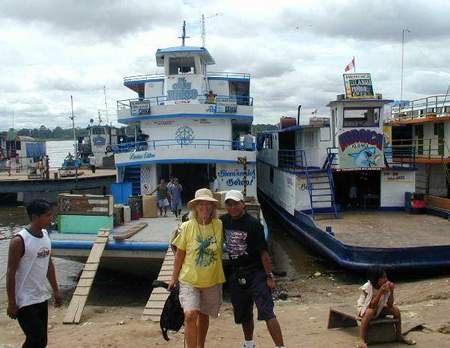Adventures aboard SV/Thaleia
| Perú: Iquitos, Pevas and the Amazon Basin |
| Iquitos is Perú's largest jungle city. It is on the Amazon and is surrounded by its tributaries, the Rio Nanay and the Rio Itaya. Iquitos is accessible by boat on the Amazon or by air but not by road. This fact is even more amazing when you see the size of the city (the population is around 400,000--mostly indigenous people with a few ex-pats thrown in). A city that flourished during the rubber boom in the late 1800's, Iquitos thriives today on tourism and oil. It is arguably the most crime-free city in Perú and perhaps in South America; it's safe to walk through the downtown day or night. It is used as a base for excursions into la selva (the jungle), but we found it worthy in itself of a visit. We flew to Iquitos without an itinerary, but with an idea of booking passage on a cargo river boat to explore the down-river town of Pevas. While in Iquitos, we enjoyed our stay at La Pascana, a small hotel close to the waterfront, and we stored our bags there while we visited the Amazon via cargo boat. | |
|
The motocarro is the chief means of transportation in Iquitos. We met Alfredo in front of the office of tourism on the Plaza de Armas, and hired him to take us in his motocarro on a personalized tour of Iquitos. It was a good choice--it included the ports on the river, a stop at his Bella Vista house to meet his 3-day-old son, a trip to Belén and a taste tour through the market. He also arranged a trip to the Butterfly Farm, one of the highlights of our stay in Iquitos. | |
| These beautiful buildings are examples of the buildings constructed by the rubber barons during the opulent days of the late 19th century.
| |
| Below is the Iron House, designed by Eiffel (of Paris) and imported piece by piece, up the river, then assembled in Iquitos on the town square circa 1890. Many of these lovely structures built along the river were used as warehouses, but today, the Iron House sports a cafe downstairs and a bar upstairs.
| |
|
| Hey! They liked Ike too! |
|
This is the plaza at the Iquitos public university. Of course, the macaw is the national bird. Students with little means who can pass the entrance exams can study for a relatively small fee, and students who don't pass the exams can study close by at a remedial center where they can hope to beef up on the math, Spanish, and English skills so they can be admitted to the University. One of the most popular programs is the tour guide course of study. Graduates work as guides in the jungle, the rainforest, and at Inca ruin sites all over Peru, with the plum site, of course, being Machu Picchu.
|
|
| On our trip to Puerto Bella Vista, Alfredo stopped at the town market where the cooks gather to prepare lunch and others sell fruits and vegetables. It appears that the houses don't have elaborate cooking facilities, and so the women cook in the communal grill/oven center. Below, a woman mashes the cooked plátanos (plantains) and will mix the mash with pork fat. She then forms tacacho (balls about the size of a softball) to cook on leaves on the grill (see below). I'm here to tell you that they are good! | |
|
|
Also on the grill are these skewered seeds of a palm fruit (I think they're called pijuayo) that taste starchy, like a plátano or potato. |
| Let's eat! Tacachos, plátanos, y pijuayo anyone?
| |
| And fish?
Fresh fish is the most available protein source in the Iquitos area. According to John Kricher in Neotropical Companion, there are over 2400 species of fish that make their home in the Amazon, including over 200 fruit eating species. For the most part, they are small fish, and very delicious. The women use the large leaves for cooking and serving these delectable fish. And these tasty treats (below) are juane--rice, olives, chicken, and eggs wrapped in banana leaves. They are similar to the traditional Venezuelan and Trinidadian holiday fare.
| |
| On to the fruit...there are many varieties I had never sampled or even seen. The aguapé below is a palm fruit concealed in a furry pod.
Notice Alfredo's shirt (above).Many peruanos have been in the U.S. for school or work, and most have relatives somewhere in the States. We were told many times that few north Americans tour this part of Perú, so we tried to be good ambassadors. |
You eat the white pulp that slides off of the seed, then discard the seed. It is sweeter than candy and delicious as a pick-me-up snack. |
| After lunch, we took Alfredo's motocarro to Belén, the Iquitos barrio where the large, somewhat chaotic market thrives. The market is about six blocks square, and many of the streets and alleys can't be traveled except on foot. Here we looked at magic potions (and I confess--I bought a small vial that promised long life and health--just to be on the safe side. Now I'm reluctant to throw it out!)
| |
| Down the steep embankment from the Belén market are the houses or huts, many floating on rafts right in the Amazon--actually, they're at the mouth of a small tributary, the Itaya River, where it joins the Amazon. The river floods during the rainy season, so the floating houses are habitable year round, whereas those on land, even on stilts, may be under water during part of the year. Alfredo took us to the edge of the river where we hired a ride from a young man with a wooden canoe and a large paddle. He paddled us up and down the river through the floating barrio. The canoes are the chief transportation mode on the river in Belén, with only a very few having a motor of any kind.
This canoe doubles as a clothes line....
And this one gives protection from the sun...it's also used for a porch. | |
|
The thatched roofs are in constant need of repair, and one sees these repairs going on everywhere. The thatched "planks" (below) are constructed, then taken up to the roof to be lashed on.
| |
|
Doing
laundry... | |
|
The children are always so darling...the people are very very poor, but the children are happy and well fed. They have fish for the taking and vegetables and fruits for almost nothing. The children did not usually ask for handouts, but were intensely curious about us. When we stopped so Alfredo could arrange the canoe ride, the children gathered around the motocarro trying to get close enough to touch me, especially my hair. When I said hello and smiled at one girl, she quickly ran to her house and grabbed her baby brother to come see me too. The longer we were there, the more children gathered around and the closer they got to us--we were absolutely charmed by their smiling faces and their curiosity. | |

| |
| These stores, also floating, seem to do a thriving business.
| |
| The
church and the school are built across the Rio Itaya on stilts.
| |
| Our visit by boat to Pilpintuwasi, Quechuan for house of the butterflies, gave us a unique opportunity to not only learn about these beautiful creatures, but to see many of them in a jungle environment. There we met Gudrun Sperrer, a transplanted Austrian who, with her Peruvian husband Robler Moreno, have built a farm to breed butterflies. They have also rescued several rare species of animals that now reside with them at Pilpintuwasi. | |
| As you approach the farm, it looks as though you've taken a wrong turn into a forest undergrowth, and then you spy the thatched roof of the butterfly farm.
| |
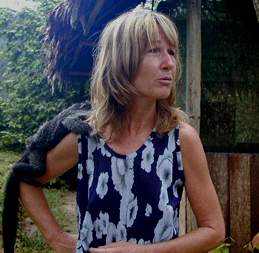 | Gudrun came to the canoe to meet us and usher us into her jungle abode. On her arm is Zecke, one of the two black Huacary monkeys that she nursed back to health who now live here with her and Robler. |
| As we walked down the path, we encountered Rosa, an orphaned giant anteater. She is content to drink milk from the dish but has to be watched lest she wander off. She probably will never have the skills to live in the wild. | |
| Chavo, a red-faced Huacary monkey, a species that only exists in the Amazon region, made his presence known immediately; when I wasn't looking, he leapt onto my hat which was on my head, scaring the bejeezus out'a me. He did it not once, not twice, but four times, each time having the same effect. Otherwise, he was a hoot! His mother was killed leaving him orphaned and Gudrun took him in and gave him life.
| |
| After walking the path, we came to the butterfly house, an enclosed garden designed to be host to many species of butterflies. It seems that each species of butterfly requires a particular host plant on which to lay their eggs. From the time the butterfly lays her eggs, it will take from 2 weeks to several months for the eggs to hatch into tiny caterpillars who eat eat eat, then, finally, become an adult butterfly. In order to breed butterflies, the host plant must be made available, and to protect the larvae, they should be enclosed in a screened room where they can grow without predators. The Butterfly House is a field trip worth taking--not only for the butterflies, but for the botany as well. Below are some photos that John managed to take while visiting the butterflies. | |
|
a monarch... |  |
|
yellow-winged transparent | |
|
the owl butterfly | |
|
a blue morph | |
|
Another animal left at her doorstep...this jaguar, Pedro Bello, lives in an enclosure that was built with donations. He requires an incredible amount of meat every day, so Gudrun raises guinea pigs for his dinner. | |
|
On our way out of the farm, we paid our respects to the blue and yellow macaw and his friend, not seen here, a red and green. | |
|
Our next adventure was our Amazon river trip, probably the most unique experience we've shared in all of our travels. From Iquitos, we booked passage on the Heroica, along with more people than we thought could ever fit on this small vessel, dozens of chickens, pigs, sacks of potatoes, onions and oranges, and many huge crates of ice, all to be delivered to the fishing villages down river We left around 6:00 in the evening and, after many stops along the way to unload people and cargo, arrived at 6:00 the next morning at the bustling wharf in the otherwise quiet village of Pevas. Pevas is the oldest town on the Peruvian Amazon and is inhabited by some 2500 people (no cars or telephones). They run generators for electricity between 6:00 and 10:00 PM (though when we were there, the generator ran a bit longer to accommodate a soccer game on TV that wasn't over until 11:00). We chose Pevas for two reasons: one, Francisco Grippa, a very famous and well-loved artist lives and works in Pevas; and two, there is a lodge in Pevas, Casa de la Loma, that was written up in Lonely Planet and sounded like an interesting place to hang out for a few days. Though the lodge was not really open for business (it had been sold), we met the new manager, Abelardo, in Iquitos and he invited us to stay at the lodge with him and his family. | |
|
As the boat made its way down river, it stopped in unmarked spots along the shore where only the grasses were slightly worn down indicating recent traffic. Suddenly, five or six people would appear out of the jungle to accept the cargo, usually large crates of ice. This went on all through the night, and we were incredulous that the captain not only knew exactly where to stop, absent any visible signs of a village, but knew the water depths well enough to snake his way into the shore without buoys or other markers and without going aground. | |
|
Berthing on the ship was in hammocks; there were two rows of hammocks below decks and two above decks, probably no fewer than 50 or 60. Since we didn't get to the ship early enough to find a spot on the upper deck, we were relegated to the cargo hold with the chickens and bags of produce. As you can see, the hammocks were slung so close to each other that the only way you could get out of the hold and up on deck was to crawl on your hands and knees under all the hammocks to the ladder. If anyone moved in his hammock, it set off a chain reaction and we all swayed in unison. Needless to say, we didn't get much sleep.
As the dawn broke, I went topsides and sat with a family on the bench by the pilothouse to watch our approach to Pevas. | |
|
The
landing of the cargo boats every morning is the hub of commercial life here in
Pevas. | |
|
All of the marketing is done early; by 10:00 in the morning, everyone has packed up and gone home. There are no restaurants or shops other than those at the docks, and they don't do business after noon. | |
|
The town has constructed a laundry facility here at the river (a small tributary to the Amazon), which is simply a cement platform next to the bridge. There is fresh running water and plenty of space for doing laundry and socializing.
More darling kids than you can believe... | |
|
This little boy saw our camera and came running. He wanted us to take his picture so he could see himself in the camera and he was delighted with the results! | |
| The towns in the Amazon Basin, such as Iquitos and Pevas are inhabited primarily by Mestizos, people who are a mix of Indian and Spanish, while the tribal groups, such as the Boras and Shipibos inhabit the small villages along the river banks. Abelardo is a member of the Boras tribe whose family still lives in the tribal village on the river bank. We visited his mother, father, and several brothers and sisters, who live in huts similar to these below. They still fish and hunt for food, using hand carved canoes and blow guns. They gather plantains and fruit from the jungle and have an issue of rice, sugar and other staples from the government.
| |
|
These canoes are the only transport that most villagers have. Some have motors, but many use paddles and stay close to the banks and on the less raucous tributaries.
|
Abelardo hired a friend to take us by pecky-pecky (a wooden planked canoe powered by a brand new outboard) to a Boras village where we met the chief and his representative who agreed to guide us on a jungle walk (slog) through the secondary forest around the village.
We made our way down this small tributary to the mighty Amazon, not realizing that we had to cross the river in this small craft. The current was running about 4 knots, but our guy handled the canoe very deftly and put us ashore at exactly the right spot. We were very aware that a failed motor would make our return upriver difficult to impossible. |
| The village was set on a small stream off of the Amazon (as most are). Their houses are built on stilts to withstand the rising waters, and they are built in a clearing that accommodates a common area and 5 or 6 huts. The thatched roofs provide shade and keep them dry, but there is no protection against insects and other creatures. They are surrounded by jungle.
| |
| This is a hand carved sugar cane press that's used, of course, to extract the juice from the cane. It has spokes on both sides which are turned in opposite directions to get the wringer effect.
| |
| The village chief gave us permission to walk in the jungle around their compound, but asked us to take the canoe around to the other side. The children seized the opportunity for a canoe ride with the blond lady and the grey-bearded gringo.
Abelardo (left), the village guide and his son accompanied us on a two-hour walk through the jungle. Because it is secondary growth, the jungle is thick and difficult to traverse. Of course, the machete is in my hands only for the photo op--our guide wielded it to help clear the path of vines and critters, though we were glad to be wearing knee-high rubber boots.
|
For us, the incredible diversity of the jungle flora was a sight right out of Darwin's journals. For the natives, the flora offers medicines, magic, tints and dyes, spiritual hallucinogenic drugs, and food. To a number, all of the people we met were very generous with their time and anxious to share their homes with us. |
| These children live in a fish camp on the river with their parents. This was the same camp we saw from the cargo boat when we stopped to unload the crates of ice (covered with the green and blue tarps). After several days, one of the fishermen will take the crates full of ice and fish back to Iquitos on the cargo boat, and will sell them at the Iquitos market.
| |
| After several days in Pevas, we booked passage on a larger, more luxurious cargo boat, El Gran Diego. Of course, it also carried pigs and chickens, but we managed to have space on the upper deck.
| |
|
The trip back to Iquitos from Pevas is about 24 hours, so we were very happy to be able to rent a cabin. They offered us the captains quarters with a king size bed, and we didn't hesitate to move in. Passage on this boat included all food. We were treated like royalty. | |
| These kids had been on a field trip from school into la selva (the jungle). They study English in school, so they were happy to practice on us. | 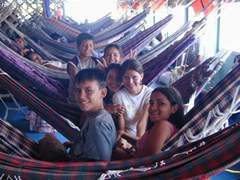 |
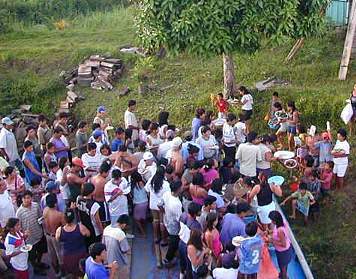 |
The boat stopped at this village and everyone was waiting. The women came on board with empanadas and other goodies, while the kids just played and socialized. It was cacaphonous! Our young friends above took me ashore with them to have a quick swim and to make a photo.
|
|
Back
in Iquitos, we stopped at the market square for some fruit,
| |

